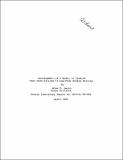Development of a model to predict flow oscillations in low-flow sodium boiling
Author(s)
Levin, Alan Edward; Griffith, P.
DownloadEL_TR_1980_006.pdf (8.582Mb)
Other Contributors
Massachusetts Institute of Technology. Sodium Boiling Project.
Metadata
Show full item recordAbstract
An experimental and analytical program has been carried out in order to better understand the cause and effect of flow oscillations in boiling sodium systems. These oscillations have been noted in previous experiments with liquid sodium, and play an important part in providing cooling during Lossof- Piping Integrity (LOPI) accidents that have been postulated for the Liquid Metal-Cooled Fast Breeder Reactor. The experimental program involved tests performed in a small scale water loop. These experiments showed that voiding oscillations, similar to those observed in sodium, were present in water, as well. An analytical model, appropriate for either sodium or water, was developed and used to describe the water flow behavior. The results of the experimental program indicate that water can be successfully employed as a sodium simulant, and further, that the condensation heat transfer coefficient varies significantly during the growth andcollapse of vapor slugs during oscillations. It is this variation, combined with the temperature profile of the unheated zone above the heat source, which determines the oscillatory behavior of the system. The analytical program has produced a model which qualitatively does a good job in predicting the flow behavior in the wake experiment. Quantitatively, there are some discrepancies between the predicted and observed amplitudes of the oscillations. These discrepancies are attributable both to uncertainties in the experimental measurements and inadequacies in modelling the behavior of the condensation heat transfer coefficient. Currently, several parameters, including the heat transfer coefficient, unheated zone temperature profile, and amount of mixing between hot and cold fluids during oscillations, are set by the user, and have a deterministic effect on the behavior of the model. Additionally, criteria for the comparison of water and sodium experiments have been developed. These criteria have not been fully tested. Several recommendations for future study are proposed, in order to advance the capability of modelling the phenomena observed.
Date issued
1980Publisher
Cambridge : Massachusetts Institute of Technology, Energy Laboratory, 1980
Series/Report no.
Energy Laboratory report (Massachusetts Institute of Technology. Energy Laboratory) no. MIT-EL 80-006.
Keywords
Liquid metal fast breeder reactors., Two-phase flow, Liquid sodium., Sodium cooled reactors.